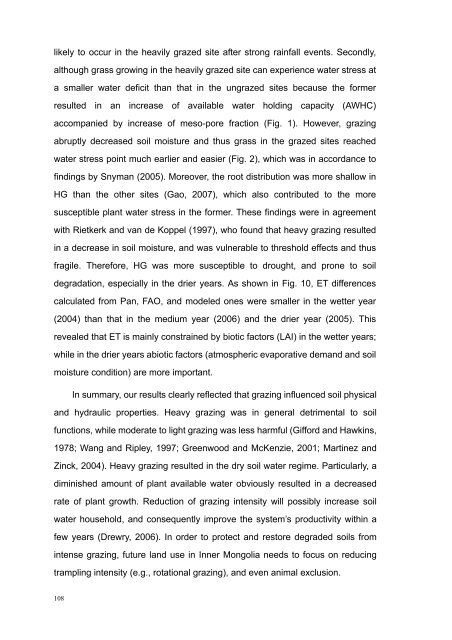SCHRIFTENREIHE Institut für Pflanzenernährung und Bodenkunde ...
SCHRIFTENREIHE Institut für Pflanzenernährung und Bodenkunde ...
SCHRIFTENREIHE Institut für Pflanzenernährung und Bodenkunde ...
You also want an ePaper? Increase the reach of your titles
YUMPU automatically turns print PDFs into web optimized ePapers that Google loves.
likely to occur in the heavily grazed site after strong rainfall events. Secondly,<br />
although grass growing in the heavily grazed site can experience water stress at<br />
a smaller water deficit than that in the ungrazed sites because the former<br />
resulted in an increase of available water holding capacity (AWHC)<br />
accompanied by increase of meso-pore fraction (Fig. 1). However, grazing<br />
abruptly decreased soil moisture and thus grass in the grazed sites reached<br />
water stress point much earlier and easier (Fig. 2), which was in accordance to<br />
findings by Snyman (2005). Moreover, the root distribution was more shallow in<br />
HG than the other sites (Gao, 2007), which also contributed to the more<br />
susceptible plant water stress in the former. These findings were in agreement<br />
with Rietkerk and van de Koppel (1997), who fo<strong>und</strong> that heavy grazing resulted<br />
in a decrease in soil moisture, and was vulnerable to threshold effects and thus<br />
fragile. Therefore, HG was more susceptible to drought, and prone to soil<br />
degradation, especially in the drier years. As shown in Fig. 10, ET differences<br />
calculated from Pan, FAO, and modeled ones were smaller in the wetter year<br />
(2004) than that in the medium year (2006) and the drier year (2005). This<br />
revealed that ET is mainly constrained by biotic factors (LAI) in the wetter years;<br />
while in the drier years abiotic factors (atmospheric evaporative demand and soil<br />
moisture condition) are more important.<br />
108<br />
In summary, our results clearly reflected that grazing influenced soil physical<br />
and hydraulic properties. Heavy grazing was in general detrimental to soil<br />
functions, while moderate to light grazing was less harmful (Gifford and Hawkins,<br />
1978; Wang and Ripley, 1997; Greenwood and McKenzie, 2001; Martinez and<br />
Zinck, 2004). Heavy grazing resulted in the dry soil water regime. Particularly, a<br />
diminished amount of plant available water obviously resulted in a decreased<br />
rate of plant growth. Reduction of grazing intensity will possibly increase soil<br />
water household, and consequently improve the system’s productivity within a<br />
few years (Drewry, 2006). In order to protect and restore degraded soils from<br />
intense grazing, future land use in Inner Mongolia needs to focus on reducing<br />
trampling intensity (e.g., rotational grazing), and even animal exclusion.


